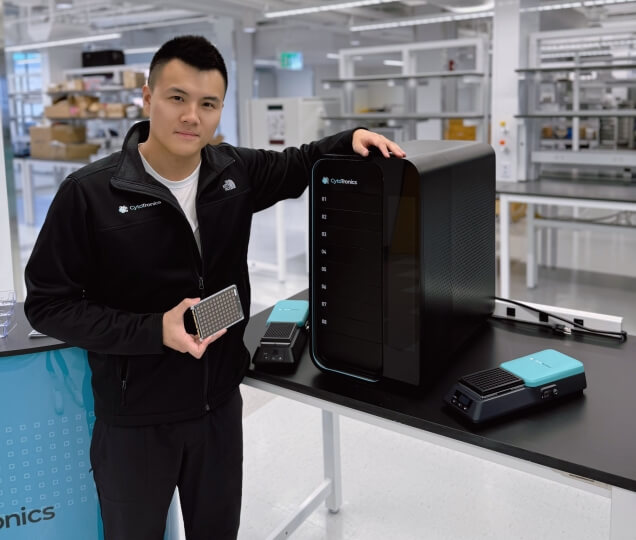Vince Wu, Ph.D. '21
Vince Wu first came across the idea of using semiconductors in a biological setting as an undergraduate at the University of Washington. Semiconductors are a critical component of pretty much all electronic devices, but at Washington there were labs using them to screen blood samples for pathogens.
“I realized that while semiconductors have transformed information technology, their potential in biology was largely unexplored,” said Wu, Ph.D. ’21. “With both of my parents being medical doctors, I’ve always had a natural interest in biology.”
That interest in using semiconductors in biological research eventually led him to the Harvard John A. Paulson School of Engineering and Applied Sciences (SEAS). He joined the research group of Donhee Ham, John A. and Elizabeth S. Armstrong Professor of Engineering and Applied Sciences, as a Ph.D. student in electrical engineering, where he advanced ongoing research into what are known as complementary metal-oxide-semiconductor (CMOS) chips – semiconductor-based integrated circuits used to study the activity of neurons and cardiac cells.
Once he joined the lab, Wu met Jeffrey Abbot, an established Ph.D. student who’d already published on a previous version of the CMOS chip. As the two began to work together, they realized the chip could potentially be used to study the activity of all kinds of different cells, not just cardiac cells and neurons. The chip could also support a much larger number of simultaneous cell analyses, making it a potentially high-impact technology for use across cell biology research.
“Testing a single cell culture well is useful in research, but in industry, scientists need to test many wells – across different drugs and replicates – to identify real hits,” he said. “We had developed the most advanced biology-focused CMOS technology, far ahead of anything else in academia. That sparked the idea of starting a company—something I’d always wanted to do. We began exploring commercial applications, collaborating with a lab at Harvard Medical School to test cell types beyond neurons and cardiac cells.”
That company became CytoTronics. Founded in 2021 in Boston and licensed by the Harvard Office of Technology Development, CytoTronics has translated Wu and Abbott’s research into commercial product that enables high-throughput, label-free and unbiased analysis of cell structure and activity. Their technology has wide range of applications in drug discovery as well as toxicology.
Wu serves as Chief Technical Officer at CytoTronics, while Abbot is CEO. Ham is listed as a scientific co-founder, as is Hongkun Park, Professor of Chemistry and Chemical Biology and of Physics, whose lab collaborated with the Ham Research Group.
“We stay in close touch with Donhee—he’s a brilliant mind in the field,” said Wu. “I’m really happy with where I am today, and choosing Harvard was definitely the right step to get here.”
Born in China to two parents with advanced degrees, Wu always figured he’d pursue a Ph.D., even if he didn’t yet know the specific field. He was good at math and physics in high school, and was drawn to electrical engineering at Washington because it drew on those disciplines. Wu’s undergraduate advisor, Chris Rudell, knew about Ham and his research, and eventually recommended Wu join the SEAS lab.
“I remember visiting Donhee’s lab around March 2015,” Wu said. “I got off the plane, and it was snowing, and I wondered what the heck was going on. In four years in Seattle, I only saw snow once.
“One of the most important things about Donhee’s lab is that he struck a balance between letting the students innovate and explore while providing high-level guidance. I’ve seen other principal investigators who micromanage, and that’s not my style.”
Once here, Wu devoted himself full time to CMOS research, including winning an award from Analog Devices in 2018. His dissertation focused on scaling up CMOS chips to enable higher throughput cell analysis application, and he said “that became the foundation of CytoTronics.”
“In research, it’s enough to get one prototype working and publish the results,” he said. “But for commercial use, scalability is everything. By moving from a single well to 96 or even 384 wells, we can test more conditions, generate data faster, and unlock new possibilities for accelerating cell biology research.”
CytoTronics has already raised over $22 million across two seed rounds of funding. The company has approximately 50 customers, more than 30 of which are already using its award-winning main product, called Pixel. As CTO, Wu splits his time working with the engineering, biology, and data science teams to push novel applications forward, supporting the commercial team with customer support and assisting fundraising efforts.
“Our work at Harvard pushed the boundaries of cardiac and neurological research,” Wu said. “Donhee’s support and openness to student-driven innovation made CytoTronics possible. He gave us the freedom to explore ideas beyond the core research thesis. Now, we’re turning those specialized applications into real-world tools that are exciting pharmaceutical companies.”
Press Contact
Matt Goisman | mgoisman@g.harvard.edu
